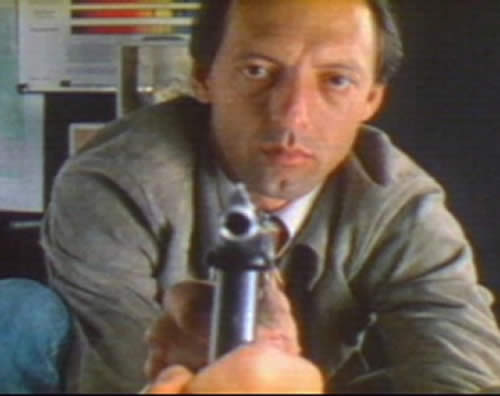 Los Angeles FilmForum is delighted to present renowned filmmaker Jon Jost in person for three different shows in Los Angeles on March 16-18. This rare visit by the filmmaker, currently based in South Korea, will allow audiences to view two rarely-screened feature films that be made in Los Angeles in the 1970s, and also feature the U.S. premiere of a new digital video work.
Los Angeles FilmForum is delighted to present renowned filmmaker Jon Jost in person for three different shows in Los Angeles on March 16-18. This rare visit by the filmmaker, currently based in South Korea, will allow audiences to view two rarely-screened feature films that be made in Los Angeles in the 1970s, and also feature the U.S. premiere of a new digital video work.
The series starts on Friday March 16th with “Chameleon” (1978, color, 90 minutes). A scathing portrait of the Hollywood/LA arts milieu of the late 70’s, Jon Jost’s “Chameleon” follows the amorphous day of its lead character, an Armani-jacketed peddler of high-class dope, fraudulent art, and preening postures suited-to-fit the changing victims. In proximate association with Filmforum’s series Alternative Projections: Experimental Film in Los Angeles, this almost never-screened film returns to the town of its making.
This is the first of three nights with Jon Jost in Los Angeles. Saturday March 17 at 5:00 pm he’ll be at Cinefamily with his other Los Angeles-based film “Angel City”. Sunday March 18, 7:30 pm he’ll be at Filmforum at the Egyptian with the U.S. premiere of “Swimming in Nebraska “
Los Angeles Filmforum presents Jon Jost’s Chameleon
In person: Jon Jost Friday March 16, 2012 8:00 pm
at the Echo Park Film Center, 1200 N. Alvarado St. (at Sunset), Los Angeles CA 90026, (213) 484-8846
Tickets: General $10, Students/seniors $6; free for Filmforum members
Advance ticket purchase available through Brown Paper Tickets.
http://www.brownpapertickets.com/event/229575
“Angel City” Saturday March 17 5:00 pm
Cinefamily 611 N Fairfax Avenue, LA 90036
info@cinefamily.org
(323) 655-2510
“Swimming in Nebraska ” Sunday March 18, 7:30 pm Filmforum at the Egyptian. U.S. premiere of Jost’s newest Video work.
“Jon Jost’s Chameleon was probably the happiest instance of a mixed marriage at the Festival (Edinburgh 1979): combining a freak, trippy (in fact almost Corman-esque) saga of a dope-dealer and all-round hustler with an abstract distillation of patterns of color and light. The place of the latter in the film is both somewhere within the drug-laced nimbus of its title character, Terry (Bob Glaudini), and somewhere outside its ironic description of the rampant merchandising of all other human activities. In a way, this abstract element almost serves as a secondary narrative, or at least becomes the ‘point’ of the film – Richard Combs, American Film
“Jost’s Chameleon cost a mere $35,000 to make (including the 16 to 35mm blowup) and is a triumph of artistry over budget. Jost’s day in the life of a lean, mean Los Angeles hustler (Bob Glaudini) is a cautionary tale about the self-destructiveness of American opportunism. The main character – hero or villain, according to taste – moves reptile-like through a land of easy-prey gullibility, sucking dry his victims and his own humanity alike. The film is packed with bold visual metaphors. When a gun is fired, the whole screen explodes into white; when the hustler changes his “act” for different clients, the screen, chameleon like, changes its colors. Chameleon is a nervy, intelligent, exciting advance on Jost’s last film, Angel City.” – Nigel Andrews, American Film, 1979
JON JOST
Born in Chicago on May 16, 1943, of a military family, Jon Jost grew up in Georgia, Kansas, Japan, Italy, Germany and Virginia. Expelled from college in 1962, he began making 16mm films in January, 1963. He is self-taught. He has made some 20+ shorts and 14 feature length films on celluloid, 16 and 35mm, all of which he has conceived, written, photographed, directed and edited; most of these he also produced. Since 1996 he has worked only in Digital Video (DV), completing 18 full-length works and many shorts, as well as one large-scale 7 screen installation work, TRINITY, presented at the ZKM, Karlsruhe Germany, in this medium as of 2009.
After 10 years of making short works, Jost made his first feature-length film in 1974, and since devoted himself to the making of a wide-ranging series of films, largely focused on specifically American topics, in forms ranging from essays (Speaking Directly, Stagefright, Plain Talk & Common Sense), to fictions (Last Chants for a Slow Dance; Bell Diamond) to documentaries (Nas Correntes De Luz da Ria Formosa, London Brief) and hybrids such as Angel City. In Digital Video his work shifted to include highly abstract works such as Passages, Trinity and Dissonance
His work has shown widely in museums, film archives, and festivals since 1975. Most recently his films were accorded full retrospectives at the Cinemateca Portuguese (1996) and the Filmoteca Español (1997), and in 2006 the Buenos Aires Independent Festival accorded his work a partial retrospective. He has been regularly invited to major film festivals with new work, including Venice (2004), Rotterdam (2008), Berlin, Toronto, London, Edinburgh, Sydney, Yamagata, Jeonju, Singapore, and many others.
Jost’s recent work, “Homecoming”, was shown at the Venice Film Festival, Cinema Digitale section, in Sept. 2004, and then was shown at the Rotterdam festival in January 2005, as well as being in competition at Jeon Ju, Korea. Since 2006 his works, “Passages,” “La Lunga Ombra” and “Overhere” were screened at the Rotterdam Festival, and subsequently at Jeon Ju, Warsaw, Frankfurt, Split, San Jose Maverick and other festivals. His most recent film, Imagens de uma cidade perdida was shown in Rotterdam and in competition at the Yamagata documentary festival in Japan in Oct 2011.

